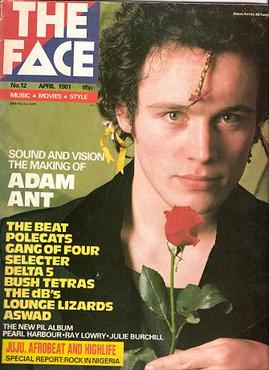
Kerrang! is a British music webzine and quarterly magazine that primarily covers rock, punk and heavy metal music. Since 2017, the magazine has been published by Wasted Talent Ltd. The magazine was named onomatopoeically after the sound of a "guitar being struck with force".

Q was a popular music magazine published monthly in the United Kingdom. It was founded in 1986 by broadcast journalists Mark Ellen and David Hepworth, who were presenters of the BBC television music series The Old Grey Whistle Test. Q's final issue was published in July 2020.

Popular Science is an American digital magazine carrying popular science content, which refers to articles for the general reader on science and technology subjects. Popular Science has won over 58 awards, including the American Society of Magazine Editors awards for its journalistic excellence in 2003, 2004, and 2019. With roots beginning in 1872, Popular Science has been translated into over 30 languages and is distributed to at least 45 countries.
Ascential plc, formerly EMAP, is a British business-to-business media business specialising in exhibitions & festivals and information services. It is listed on the London Stock Exchange and is a constituent of the FTSE 250 Index.
Newsfield Publications Ltd was a British magazine publisher during the 1980s and early 1990s.

Heat is an English entertainment magazine published by Bauer Media Group. Its mix of celebrity news, gossip, beauty advice and fashion is primarily aimed at women, although not as directly as in other women's magazines. It also features movie and music reviews, TV listings and major celebrity interviews.

Loaded was a men's lifestyle magazine. It launched as a mass-market print publication in 1994, which ceased being issued in March 2015, but relaunched as a digital magazine on 11 November 2015. The content later changed, with semi-clothed women becoming absent.

TV Week is a weekly Australian magazine that provides television program listings information and highlights, as well as television-related news.

Hit40UK was a networked Top 40 chart show broadcasting on around 130 UK commercial radio stations every Sunday from 4pm to 7pm. It was also a TV programme shown on 4Music. The radio version was produced in house by Global Radio and Somethin' Else. The show was cancelled on 7 June 2009 and the last number 1 single was Boom Boom Pow by The Black Eyed Peas, played at 6:52pm.
AW is a monthly track and field magazine published in the United Kingdom by Athletics Weekly Limited. The magazine covers news, results, fixtures, coaching and product advice for all aspects of track and field, cross-country, road racing and race walking. Between 1945 and 2020, it was called Athletics Weekly and was published weekly.
Nick Logan is an English journalist, editor and publisher.
Soaplife was a soap opera magazine published in the United Kingdom by TI Media. The magazine was first published in 1999 and focused on British and Australian soap operas. It was originally published monthly, before changing its frequency to fortnightly in 2004 when it underwent a relaunch. The relaunch focuses on an emphasis on photography and features more television shows. Staff worked on the redesign over six months. Soaplife's publishing frequency was increased to weekly in 2018 following an increased demand for the magazine. On 26 July 2018, it was announced that the magazine would cease production after failing to sell enough copies.

The Face is a British music, fashion, and culture monthly magazine originally published from 1980 to 2004, and relaunched in 2019.
Mark Frith is a British journalist and editor. He has been a writer and editor for magazines such as Smash Hits, Time Out and Heat. He has since branched into TV and radio presenting and is an author of novels.

Heinrich Bauer Publishing, trading as Bauer Media Group, is a German multimedia conglomerate headquartered in Hamburg. It operates worldwide and owns more than 600 magazines, over 400 digital products and 50 radio and TV stations, as well as print shops, postal, distribution and marketing services. Bauer has a workforce of approximately 11,000 in 17 countries.
Rolling Stone Australia is the Australian edition of the United States' Rolling Stone magazine devoted to music, politics, and popular culture, published monthly. The Australian version of Rolling Stone was initially published in 1970 as a supplement in Revolution magazine published by Monash University student Phillip Frazer. It was launched as a fully fledged magazine in 1972 by Frazer and was the longest surviving international edition of Rolling Stone until its last issue appeared in January 2018.
Barry McIlheney is a British journalist, editor, broadcaster and publisher. Born in Belfast, Northern Ireland, McIlheney is a graduate of Trinity College, Dublin, Republic of Ireland, and London's City University.

Number One, initially rendered as 'No. 1', was a British magazine dealing with pop music. It ran for nine years and was aimed at a mainly teenage market.
Just Seventeen, often referred to as J-17, was a fortnightly magazine aimed at teenage girls, published by Emap from October 1983 to April 2004. A special preview edition was given away free with sister magazine Smash Hits on 13 October 1983, with the first issue published the week after on 20 October. It had become a weekly publication by early 1986. It quickly became the UK's market-leading teen-girl magazine until the launch of Sugar in 1994, after which sales began to fall. In 1997, the magazine was changed to a monthly format in response to declining circulation, and the magazine was finally closed in 2004 after losing a third of its readership.

Construction News is a monthly publication, plus digital and events services, primarily targeting the United Kingdom construction industry.











